by hankinslawrenceimages | Aug 8, 2009 | Flowers, Liliaceae Family, Wildflowers
One of my favorite spring wildflowers is the Yellow Trillium – Trillium Luteum. I first saw some yellow trillium last year when I was in the Great Smoky Mountains National Park for the Spring Wildflower Pilgrimage. Last spring, I posted two of my yellow trillium photos from that trip.
This spring, I was looking to photograph yellow trillium a little differently. I ended up with several photos that I’m pretty happy with.
Without a doubt, my favorite wildflower photograph from this spring is a group of yellow trillium and purple phacelia that I spotted along the side of River Road in the Great Smoky Mountains National Park. I spotted the trillium and phacelia early in the week – and then kept going back until I managed to get the photo that I wanted. I’m sure I entertained many other park visitors as I kept moving my tripod and camera along the roadside. This photo is what spring wildflowers in the Smokies are all about for me.
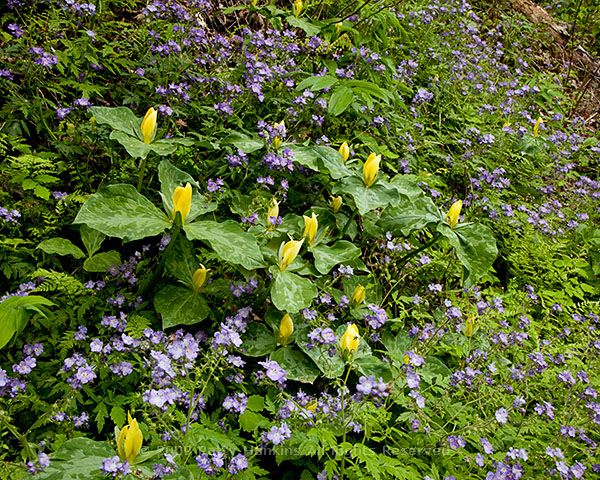 Yellow Trillium and Purple Phacelia (c) 2009 Patty Hankins
Yellow Trillium and Purple Phacelia (c) 2009 Patty Hankins
At the beginning of our spring trip to Tennessee, our friend Dan (who is an absolutely incredible photographer) took Bill and I to the Laurel Snow Pocket Wilderness in Dayton. It was absolutely spectacular way to start the trip. Two of my photos from Laurel Snow are of the yellow trillium.
First a group of yellow trillium backlit by the sun. I loved the way the light lit up the trillium petals.
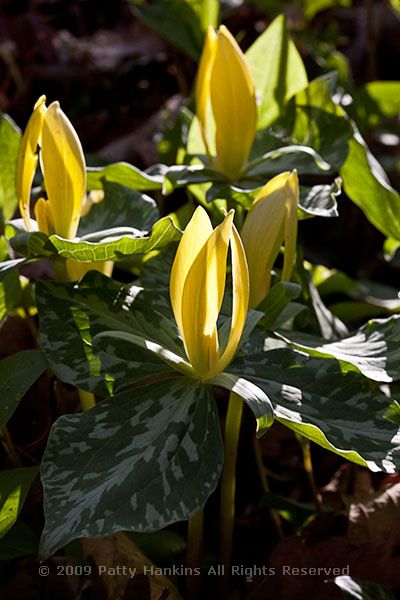 (c) 2009 Patty Hankins
(c) 2009 Patty Hankins
The second photo from Laurel Snow is a yellow trillium in front of a pair of ferns. It was one of those scenes where the plants are growing in wonderful combinations and compositions.
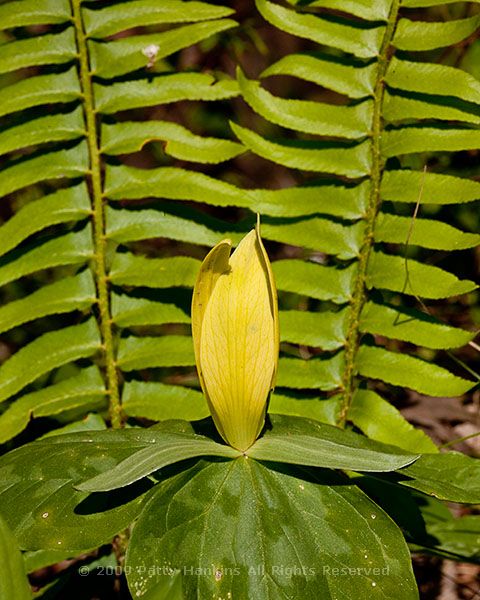 Yellow Trillium with Ferns (c) 2009 Patty Hankins
Yellow Trillium with Ferns (c) 2009 Patty Hankins
My last yellow trillium photo from this spring was photographed along the Old Settlers Trail in the Great Smoky Mountains National Park. This was the first time I’d seen a yellow trillium with its petals folded over rather than erect. I like the shape created by the petals and leaves on this particular trillium.
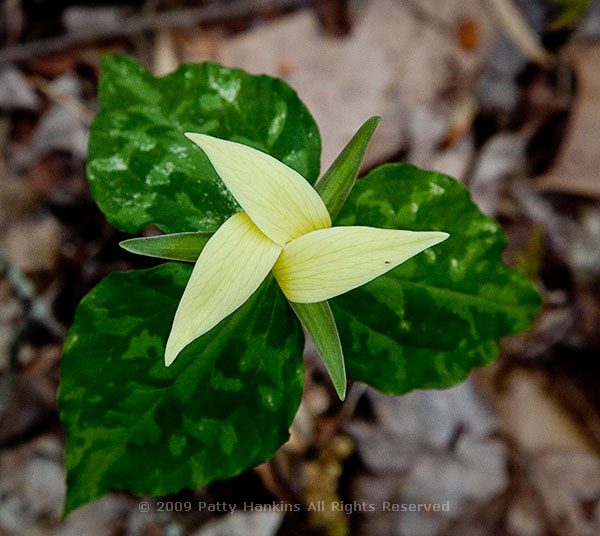 (c) 2009 Patty Hankins
(c) 2009 Patty Hankins
The yellow trillum bloom for a few weeks in the spring the Smokies – I’m already looking forward to heading back and photographing more of them next year. 🙂
by hankinslawrenceimages | May 13, 2009 | Flowers, Liliaceae Family, Wildflowers
In addition to the Vasey’s Trillium, another trillium that I photographed for the first time on my recent trip to Tennessee was Catesby’s Trillium. Like Vasey’s Trillium, the flower on the Catesby’s Trillium is found below the leaves of the plant. The flowers of the Catesby’s Trillium start out white, and turn pink as the blossoms age.
I spotted my first Catesby’s Trillium along Goforth Creek. I was photographing some violets, looked up the hillside and realized that right above me was a trillium I’d never seen. Once I checked my books, I identified it as a Catesby’s Trillium.
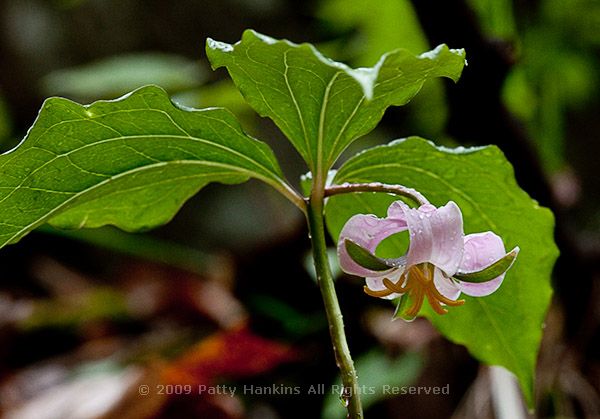
(c) 2009 Patty Hankins
This next photo shows how the blossom hangs down and the petals turn back.
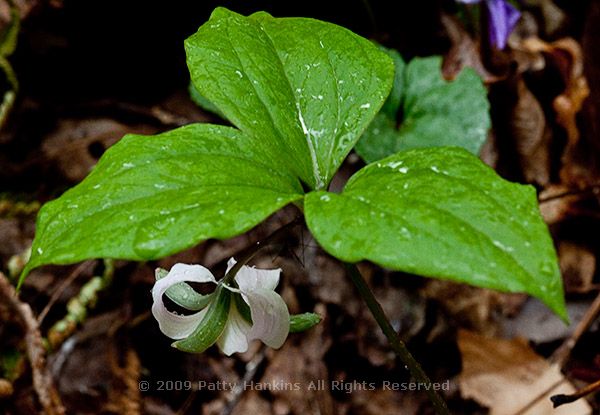
(c) 2009 Patty Hankins
As I hiked further up the trail, I spotted several more Catesby’s Trillium. This pair were right along side the trail. It was rainy and muddy the day I was hiking along Goforth Creek. I ended up lying in the mud – shooting up to get these last few photos.
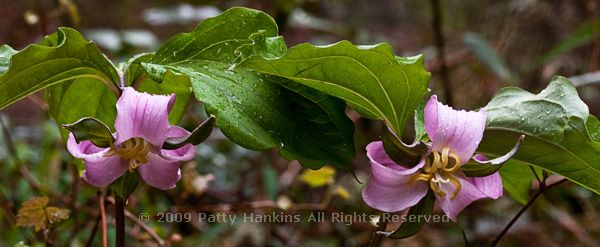
(c) 2009 Patty Hankins
This is my favorite Catesby’s Trillim photo from Goforth Creek – it really shows the detailed beauty of the flower.
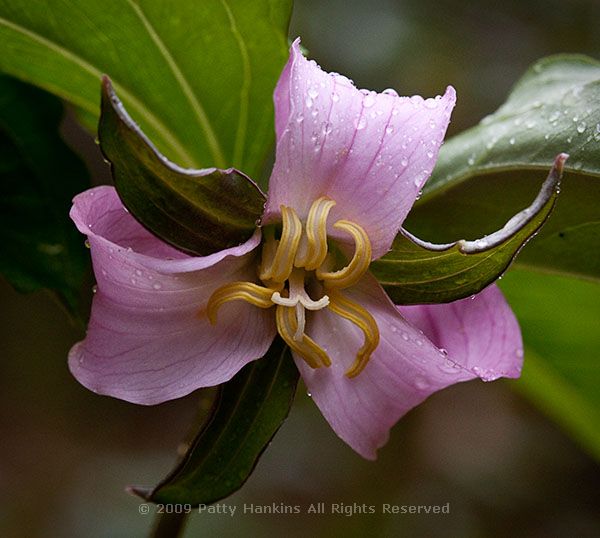 (c) 2009 Patty Hankins
(c) 2009 Patty Hankins
A few days later, I found several more Catesby’s Trillium to photograph along the Schoolhouse Gap Trail in the Great Smoky Mountains National Park. This flower was a paler pink than the ones I’d seen along Goforth Creek.
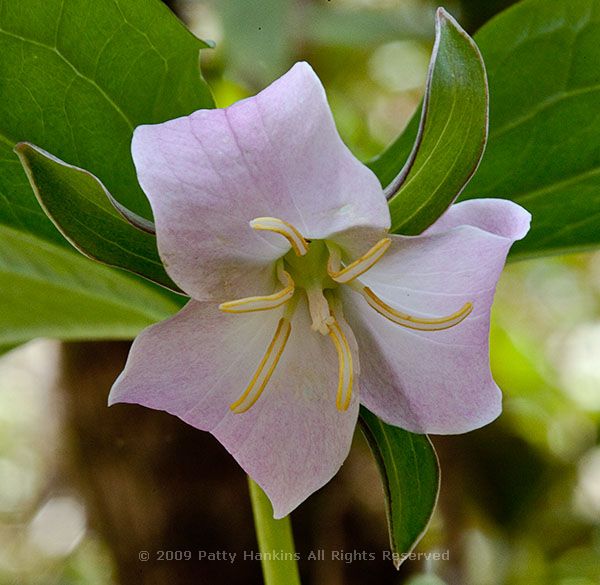
(c) 2009 Patty Hankins
This is the best looking white blossom of a Catesby’s Trillium I was able to photograph on the trip.
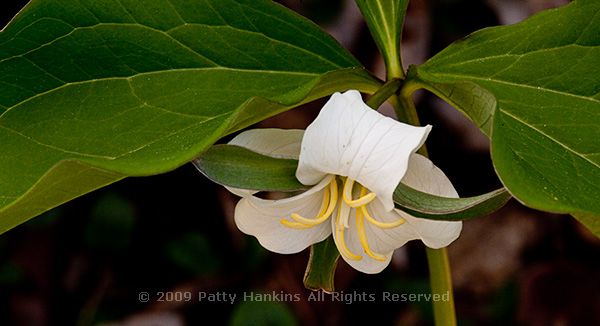
(c) 2009 Patty Hankins
The final pair of Catesby’s Trillium were photographed last week in the Fern Valley section of the National Arboretum in Washington, DC. Since the flowers weren’t hanging down, I originally thought they were another variety of trillium. But then I realized that the flowers were being pushed up from below by the next trillium down the hill. The identifying sign at the Arboretum identified these as Trillium Catesbaei. They gave the flower the common name of Rose Trillium rather than Catesby’s Trillium.
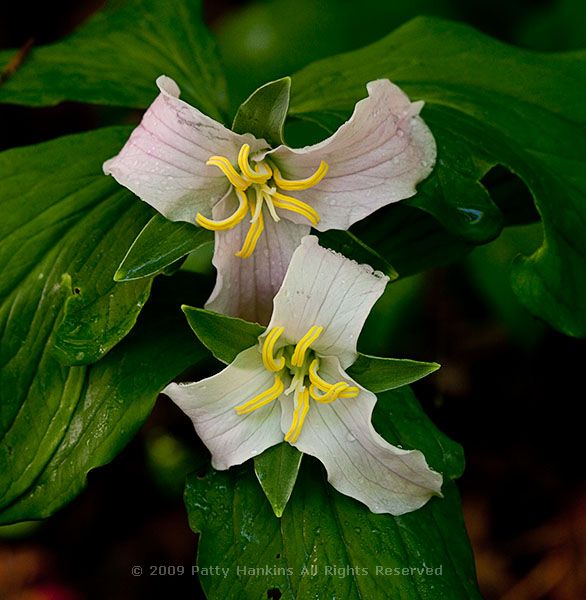
(c) 2009 Patty Hankins
As you can probably tell from the numbers of photos of various trillium that I post, trilliums are one of my favorite spring wildflowers.
by hankinslawrenceimages | Apr 29, 2009 | Flowers, Liliaceae Family, Wildflowers
I’m just back from a fantastic trip to Tennessee where I spent more than a week photographing the spring wildflowers. The wildflowers are incredible this year. 2009 was the second year in a row that I’ve attended the Spring Wildflower Pilgrimage
Last year, I photographed a couple of different types of trillium – the Sweet White Trillium and the Yellow Trillium. This year, I was able to photograph three additional trilliums – Vasey’s Trillium, Catesby’s Trillium and Sweet Betsy Trillium.
Here are some of my photos of the Vasey’s Trillium. These flowers were photographed along the Ash Hopper Trail in the Great Smoky Mountains National Park. These three Vasey’s Trillium were the only ones I saw all week – and believe me I was looking for them.
Vasey’s Trillium (Trillium vaseyi) are easy to identify. They are the trilliums with the red flowers that hang below the leaves.
The blossoms of the Vasey’s Trillium

(c) 2009 Patty Hankins

(c) 2009 Patty Hankins
Side view of the blossom
 (c) 2009 Patty Hankins
(c) 2009 Patty Hankins
Side view of the Vasey’s Trillium- the leaves on this trillium can grow quite large

(c) 2009 Patty Hankins
And finally – a Vasey’s Trillium from above
 (c) 2009 Patty Hankins
(c) 2009 Patty Hankins
I’ll be posting more wildflower photographs from the Smokies in the next few weeks. I had a wonderful time in TN and took lots (and lots) of photos.
by hankinslawrenceimages | Nov 10, 2008 | Photo Locations
On our trip to the Smoky Mountains last spring, Bill and I spent some time photographing the streams along Newfound Gap Road. We were amazed at the power of the water rushing down the mountains, and how green and lush all the vegetation was.
Here’s one of the streams
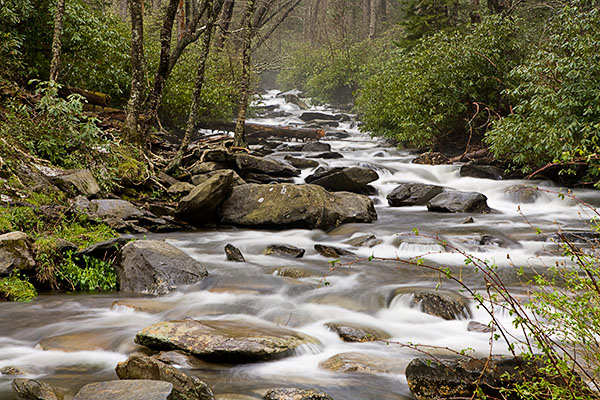
Smoky Mountain Stream (c) 2008 Patty Hankins
Further down the mountain, we came across a pair of streams that created a small pair of waterfalls as the streams joined together. We spent almost an hour photographing this one location.

(c) 2008 Patty Hankins
At one point, the water created a small waterfall over some tree roots.

(c) 2008 Patty Hankins

(c) 2008 Patty Hankins

(c) 2008 Patty Hankins
This was just a few of the streams we photographed last spring. We’re both still processing our photos from the trip – I’m sure as we work our way through the photos, I’ll be posting more photos of some of the streams.
by hankinslawrenceimages | Jun 12, 2008 | Photo Locations
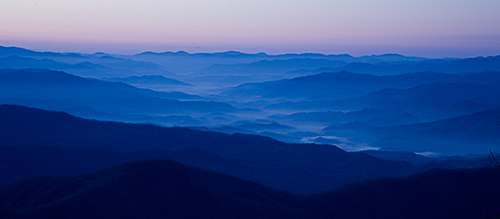
(c) 2008 Patty Hankins
As I was doing some organizing in my office this morning, I came across my file of resources on photographing in the Great Smoky Mountains National Park. Bill and I have been to the Smoky Mountains three times in the past fifteen months, and have accumulated some useful reference material. We hope this list of resources will be helpful to anyone else who is planning a photography trip to the Smokies in the future.
For any trip to a national park, we always check out the park website – the site for the Great Smoky Mountain Park is full of information. At the park, you can pick up some free information published by the Park Service including the park brochure and the newspaper Smokies Guide.
You can also purchase The Great Somky Mountains Trail map by the National Park Service for $ 1.00. The trail map is a more detailed map of the park than in the park brochure. If you’re going to be doing any hiking, you need to get the trail map.
The Great Smoky Mountains issue (issue # 24) of Robert Hitchman’s Photograph America Newsletter provides a great overview of photographic opportunities in the park. His guides are one of the first resources I check for planning any trip. This one is 12 pages long – it would take weeks to explore all the places he highlights.
The Great Smoky Mountains Association is a non-profit organization authorized by Congress to support the park. They have a series of brochures and maps which supplement the information available from the Park Service. Most of the brochures cost about $ 1.00. Our favorites include
- Cades Cove Tour – has information about many of the buildings and people who lived in the Cades Cove area
- Roaring Fork Auto Tour – information about the sites and buildings along the tour
- Newfound Gap Road Auto Tour – highlights the views and sites along the main road in the park
- Noah ‘Bud’ Ogle Place – guide to the buildings and nature trail on the road to the Roaring Fork Auto Trail
- Wildflowers – a map highlighting which trails are best for seeing wildflowers in the park
- Waterfalls – a map with information and directions to many of the waterfalls in the park
Some books we’ve found especially useful include
- Bill Campbell and Nye Simmons’ The Smoky Mountains Photographer’s Guide is full of detailed information on exactly where the best vistas and views in the park are – and includes suggestions on when to photograph them. The sunrise photograph at the top of this post was taken from the Clingman’s Dome parking lot. This book is what tipped me off as to which part of the parking lot is the best place to photograph from.
- Peter White’s Wildflowers of the Smokies is a pocket sized book with tons of information about where to find and how to identify wildflowers in the park. The flowers in the book are organized by color, which makes it easier to identify what you are seeing when you have no clue what it is.
- Hal Hubbs, Charles Maynars & David Morris’s Waterfalls of the Smokies is a companion book to Wildflowers of the Smokies. It is another pocket sized book full of information about, photographs of and directions to the many waterfalls in the park.
- Robert & William Huston & Aaron Sharp’s Great Smoky Mountains Wildflowers – another great reference for identifying wildflowers. At the back are thumbnail photos organized by color and peak bloom time to help you identify the flowers.
We hope this list of resources will give you a place to start when you plan your next photography trip to the Great Smoky Mountains National Park.
 Yellow Trillium and Purple Phacelia (c) 2009 Patty Hankins
Yellow Trillium and Purple Phacelia (c) 2009 Patty Hankins  (c) 2009 Patty Hankins
(c) 2009 Patty Hankins Yellow Trillium with Ferns (c) 2009 Patty Hankins
Yellow Trillium with Ferns (c) 2009 Patty Hankins (c) 2009 Patty Hankins
(c) 2009 Patty Hankins








 (c) 2009 Patty Hankins
(c) 2009 Patty Hankins
 (c) 2009 Patty Hankins
(c) 2009 Patty Hankins




